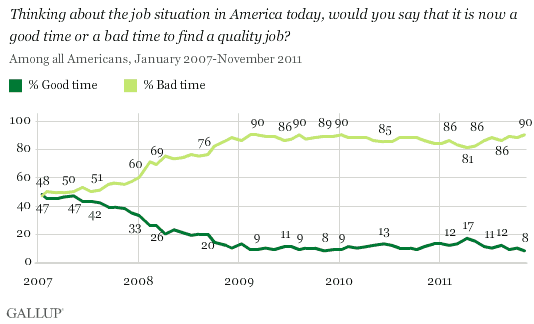PRINCETON, NJ -- Americans' assessments of the job market worsened in November and are now the most pessimistic they have been in the past decade. Nine in 10 Americans say it is a "bad time" to find a quality job, while 8% think it is a "good time."

Although each individual rating ties the worst Gallup has measured in the 11-year history of the question, not until now has Gallup recorded the 8% "good time" and 90% "bad time" readings in the same month.
The percentage saying it is a good time to find a quality job peaked at 48% in January 2007, prior to the recession. The best ratings this year were in April, when 81% said it was a bad time and 17% a good time to find a quality job.
Americans in the Workforce Provide Even Lower Ratings
Ninety-two percent of Americans who are either working or unemployed and looking for work rate November as a bad time to find a quality job, while 7% say it is a good time. Each of these ratings is the worst Gallup has measured since monitoring began in August 2001.
Younger Americans aged 18 to 29 are slightly more optimistic about the quality jobs picture, while older Americans and those with postgraduate educations are slightly more pessimistic.

Implications
Americans clearly perceive that few quality jobs are available. Although Gallup's unemployment and underemployment measurements remain high, they improved modestly in October. The government's data are also showing a slight improvement as the unemployment rate declined in October and jobless claims fell again this past Thursday.
But underemployed and unemployed statistics may not be telling the whole story, if millions of additional Americans can't find quality jobs. A lack of quality jobs reduces not only Americans' current earnings but also their future earnings because they are failing to gain experience in good jobs.
Both its magnitude and its duration make today's unemployment situation a crisis. However, there is also a crisis in terms of quality jobs. Often, currently growing companies complain that they can't find employees with the skills and experience they need. This is partly an education problem, but it is also a lack-of-experience issue, with talented Americans not getting the opportunity to gain the skills and experience these companies need. This situation is likely to worsen until the U.S. economy creates not only more jobs, but also, and just as importantly, more quality jobs.
Gallup.com reports results from these indexes in daily, weekly, and monthly averages and in Gallup.com stories. Complete trend data are always available to view and export in the following charts:
Daily: Employment, Economic Confidence and Job Creation, Consumer Spending
Weekly: Employment, Economic Confidence, Job Creation, Consumer Spending
Read more about Gallup's economic measures.
View our economic release schedule.
Survey Methods
Results for this Gallup poll are based on telephone interviews with 1,012 national adults, aged 18 and older, conducted Nov. 3-6, 2011. For results based on the total sample of national adults, one can say with 95% confidence that the maximum margin of error is ±4 percentage points.
Results for Americans in the workforce are based on telephone interviews with 537 adults, aged 18 and older, who are employed or unemployed and looking for work. For results based on this sample, one can say with 95% confidence that the maximum margin of error is ±5 percentage points.
Interviews are conducted with respondents on landline telephones and cellular phones, with interviews conducted in Spanish for respondents who are primarily Spanish-speaking. Each sample includes a minimum quota of 400 cell phone respondents and 600 landline respondents per 1,000 national adults, with additional minimum quotas among landline respondents by region. Landline telephone numbers are chosen at random among listed telephone numbers. Cell phone numbers are selected using random-digit-dial methods. Landline respondents are chosen at random within each household on the basis of which member had the most recent birthday.
Samples are weighted by gender, age, race, Hispanic ethnicity, education, region, adults in the household, and phone status (cell phone only/landline only/both, cell phone mostly, and having an unlisted landline number). Demographic weighting targets are based on the March 2010 Current Population Survey figures for the aged 18 and older non-institutionalized population living in U.S. telephone households. All reported margins of sampling error include the computed design effects for weighting and sample design.
In addition to sampling error, question wording and practical difficulties in conducting surveys can introduce error or bias into the findings of public opinion polls.
View methodology, full question results, and trend data.
For more details on Gallup's polling methodology, visit www.gallup.com.
